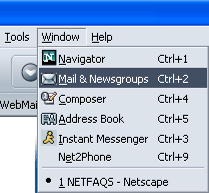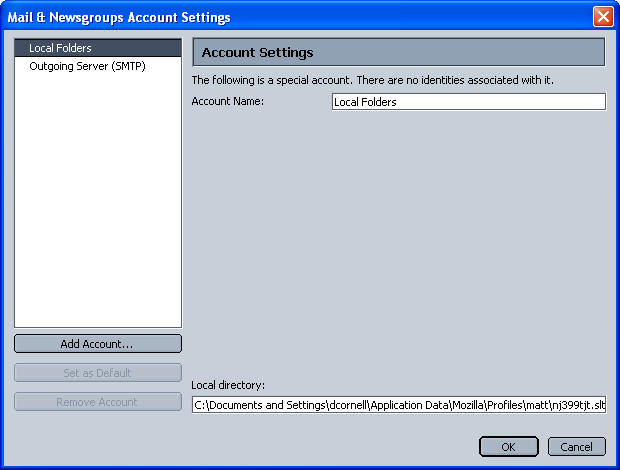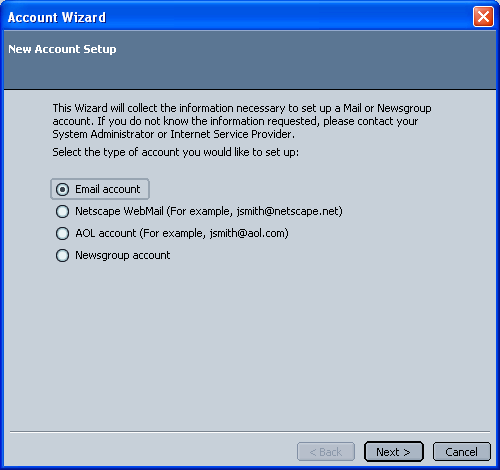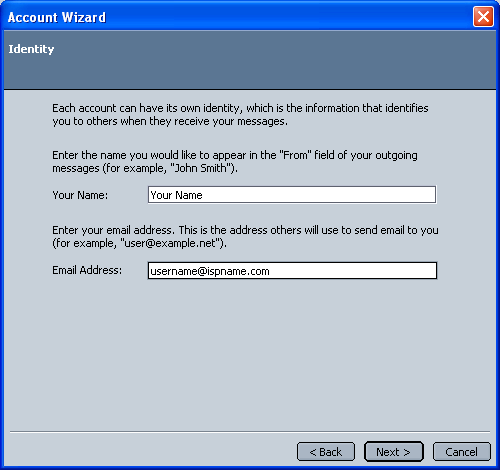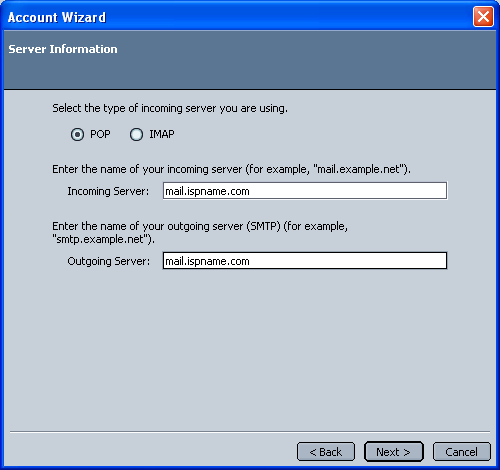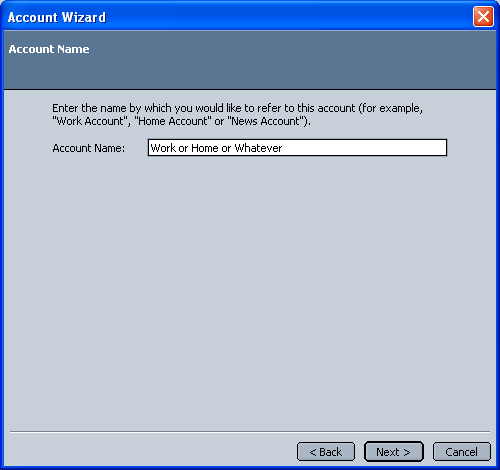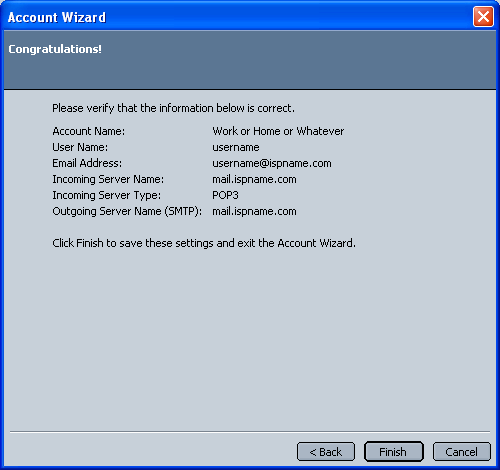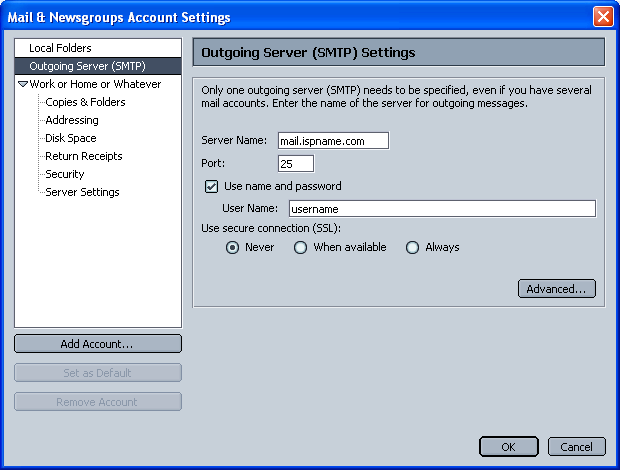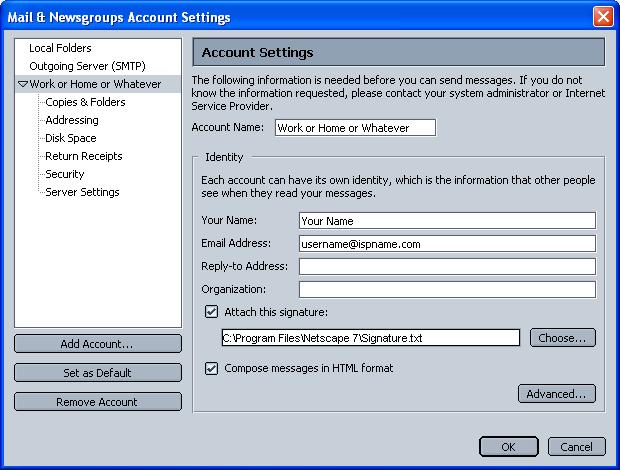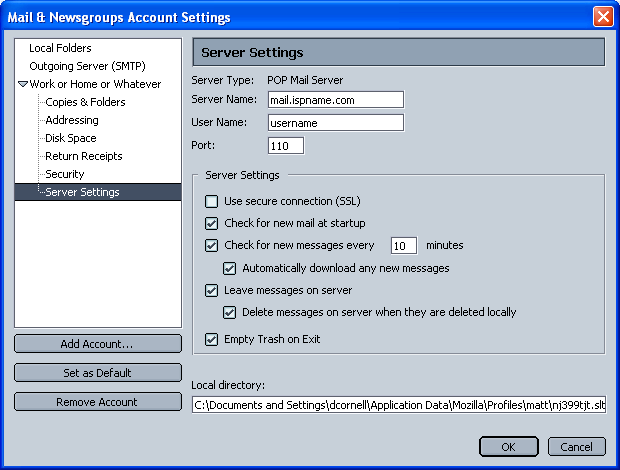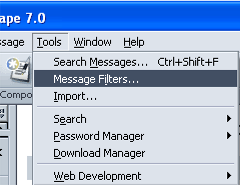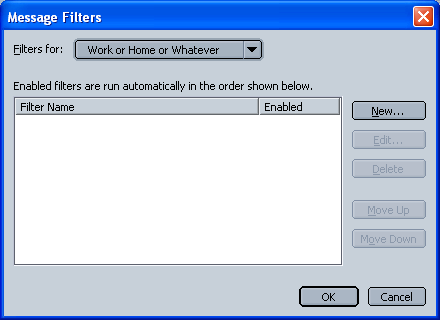|
|

|
|
|
Quick Links: Finding the Version of Netscape | Setting Up Netscape Navigator | Setting Up a Profile | Links on this page: New Mail Accounts | Editing Mail Accounts | Signatures | Folders | E-mail Filters | Newsgroups | Editing Newsgroups | SMTP Authentication | Setting Up a Netscape Mail Account Setting up an e-mail account in Netscape is simple. Begin by opening Netscape. There are several ways to open Netscape Mail. A screen shot of the toolbar is shown below.
The first option is towards the bottom left of the toolbar is the Mail envelope icon. Click on this to open Netscape Mail. Option 2, click on Window on the toolbar, select Mail & Newsgroups, as seen in the left screen shot below. A third route is to click on the envelope in the bottom right of the screen as seen in the right screen shot below. Last of all, you can select it from the Programs menu by clicking Start -> Programs -> Netscape 7.0 -> Mail & Newsgroups.
Any way you do it, Netscape Mail opens. Click the File at the top and select New -> Account from the toolbar drop-down menus.
Mail & Newsgroups Account Settings opens. Select Add Account.
The Account Wizard opens. Select Email account. Click Next. Note: To setup a Newsgroups account, click here.
Your Name = Enter your name. Email Address = Enter your full e-mail address. Click Next.
POP (Post Office Protocol) This is dotted by default. Leave it dotted. Click Next.
Username = the first part of your e-mail address (everything before the @ispname.com). It should already be entered. Click Next.
Account Name can be anything you want. If you have more than one account, the name you enter should be descriptive to avoid confusion. Click Next.
Verify the information you entered. If any information is incorrect, click the 'Back' button and correct it. Click Finish. Important: We're still not finished. We need to enable SMTP authentication. This is covered in the next section below.
Editing Mail Accounts & Setting Up SMTP Authentication We're here at Mail & Newsgroups Account Settings screen. Highlight Outgoing Server (SMTP). Place a check mark in Use name and password and enter your username in the User Name field. This is very important!
Highlight the name you gave your account. You can edit the information here. Reply-to-Address is usually left blank and then your regular address will be shown on your e-mails to friends. A signature is a word or phrase that Netscape appends to the end of each e-mail you send. If you'd like to create a signature, follow these steps: 1. Open up
Notepad and type the signature that you'd like to appear at the end of each
email. Name and save the file in a folder (My documents or the Netscape 7
folder on the C drive, etc.). Netscape will now append that signature to the end of each email you send.
Highlight Server Settings. You can edit your incoming server settings here and take advantage of certain options. For example, if you put a check mark next to Leave messages on server, you'll download your e-mail to your computer but a copy of each e-mail will remain on the server. Note: If you choose to leave a copy of messages on the server, it's a good idea to delete them periodically. If your mailbox gets too full, you won't have any room to receive new e-mail. In most cases, you don't want to leave messages on the server because your mailbox will stop accepting mail if it gets full. You only have 25 MB of mailbox so don't waste the space.
A folder is used for storing certain e-mails. For example, your Inbox stores new and undeleted e-mail while your Outbox stores e-mail waiting to be sent. You can create new folders to hold specific types of e-mail. You can even enable Netscape to automatically filter and place those emails in the Work or Family folder when the e-mail arrives. For information on Filtering, click here. To create a folder, click on File, select New -> Folder... from the dropdown menus.
The following screen appears. Name the folder whatever you need. If you'd like, you can make it a subfolder of another folder. Click OK.
In the following screen, you can see the new folder 'Work' is a subfolder of Inbox.
A Filter is a rule or set of rules that you stipulate to tell Netscape how to manage your e-mail. It is used in conjunction with Folders. It can be used for e-mail you want or don't want. For example, suppose you get unwanted e-mail from a spammer. You can create a rule to tell Netscape to delete it without you having to view or deal with it. Let's create a filter for this. On the toolbar, click Tools and select Message Filters from the drop-down menu.
The following screen appears. Click New to create a new filter.
Give the new filter a descriptive name. Click on the dropdown arrow and select Body from the menu. Select Contains from the next menu. Enter the word (s) or phrase (s) that you'd like for the rule. In this example, we used guns, violence and sex. Last, select Delete the message. This rule means that any e-mail that comes in that contains the words guns, violence or sex in the body of the e-mail will automatically be deleted. If you received e-mail that you wanted, as in the Work example earlier, you could have Netscape move it to a specific folder. You can create as many filters as you'd like.
Newsgroups are posting boards spread out across the Internet. Many specialize in posting information and discussions while others focus on distributing things like pictures. For example, a newsgroup location called alt.sports.basketball.nba.utahjazz is dedicated to Utah Jazz basketball. There are two ways to access newsgroups on the network. You can use a browser such as Internet Explorer to go directly to a news server address such as news.ispname.com. The other method is to setup an e-mail program like Netscape Mail to download newsgroups and to check newsgroups for updates on a regular basis. Click
Edit and select Mail & Newsgroups Account Settings from the drop-down menu. The following window appears. Click Add Account. The Account Wizard appears. Click to place a dot next to Newsgroup account. Click Next. Fill-in your name and e-mail address. Note: If you do not want spam then do not put your real e-mail address here. Otherwise, you'll receive hundreds of unsolicited e-mails. Most people put a bogus address in here to prevent that. Click Next. The news server address is usually something like news.ispname.com. Click Next. Account Name can be whatever you want to call it. Click Next. Verify the information you entered here. If any is incorrect, click the 'Back' button to find the necessary fields and change the incorrect information. Click Finish when your done.
Click to highlight Server Settings. You can edit the settings here and enable a few options to suit your needs. |

